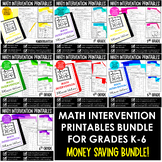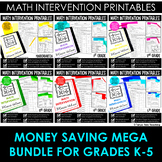Math Intervention Kindergarten 1st Grade 2nd Grade Progress Monitoring Bundle
- Zip
- Google Apps™

What educators are saying
Products in this Bundle (16)
showing 1-5 of 16 products
Also included in
- A comprehensive, no prep, standards-based bundle of RTI math intervention resources for grades K-8. This research-based intervention bundle includes tools for building a systematic, data-driven intervention process.With pre/post-tests (for each domain) for executing screening, quick checks for progrPrice $299.00Original Price $395.00Save $96.00
- A comprehensive, no prep, standards-based bundle of RTI math intervention resources for grades K-6. This research-based intervention bundle includes tools for building a systematic, data-driven intervention process.With pre/post-tests (for each domain) for executing screening, quick checks for progrPrice $225.00Original Price $308.00Save $83.00
- A comprehensive, no prep, standards-based bundle of RTI math intervention resources for grades K-5. This research-based intervention bundle includes tools for building a systematic, data-driven intervention process.With pre/post-tests (for each domain) for executing screening, quick checks for progrPrice $199.00Original Price $261.50Save $62.50
Description
A comprehensive, no prep, standards-based bundle of RTI math intervention resources for grades K-2. This research-based intervention bundle includes tools for building a systematic, data-driven intervention process.
With pre/post-tests (for each domain) for executing screening, quick checks for progress monitoring, practice pages for guided and independent practice and data tracking forms, this math intervention kit will organize and transform your intervention instruction.
Finding the time in your math block to provide RTI math intervention services to students is difficult. This grades K-2 intervention bundle saves you time by assembling all of the resources you need in one complete bundle for K-2. No more searching for the right resources and patching them together.
This progress monitoring bundle contains 5 intervention sets for each domain for grades K-2 math- all standards included!
If you purchase the bundles for each grade level individually the cost would be $110. Save $5 with this MEGA BUNDLE!
Here is what you get for each domain:
- Pre/Post Tests for each domain including item analysis for each assessment
- Quick checks for each standard
- Practice pages for each standard—segmented by procedural and conceptual understanding
- Procedural and conceptual questioning
- Progress monitoring graphing forms
- Excel RTI graphing pack
- Print (PDF) and digital versions (made within Google Slides)
---------------------------------------------------------------------------------------------------------
Each set contains the resources you need to precisely target student needs, close gaps, progress monitor and produce visual representations of intervention data as you deliver your instruction.
Use these materials to make data-driven decisions for intervention students and as preventative maintenance for your whole class.
Hyper-targeting is very important in providing intervention services and we include an item analysis with each pre-test and post-test so you can identify exactly which skills need extra support.
Procedural and conceptual questioning are included and identified so you can zero in on each students' strengths and weaknesses. Research-based principles are used in this resource and an explanation page is included if you need documentation of such for administration. Data tools for progress monitoring are included as well, including a digital Excel file for easy creation of professional looking graphs.
Take the guess work out of providing intervention and focus on what you do best…delivering quality instruction to your students!
Standards & Topics Covered for Kindergarten:
Operations and Algebraic Thinking
- K.OA.1 – Represent addition and subtraction within 10
- K.OA.2 – Solve addition and subtraction word problems within 10
- K.OA.3 – Decompose numbers less than or equal to 10
- K.OA.4 – Finding numbers that make 10
- K.OA.5 – Demonstrate fluency with addition and subtraction within 5
Number and Operations in Base Ten
- K.NBT.1 – Compose and decompose numbers from 11 to 19 into ten ones and some further ones
Measurement and Data
- K.MD.1 – Describe measurement attributes
- K.MD.2 – Comparing two objects with a measurement attribute in common
- K.MD.3 – Classify objects into given categories
Geometry
- K.G.1 – Describe objects in the environment using names of shapes, and describe the relative positions of objects using positional terms
- K.G.2 – Correctly name squares, circles, triangles, rectangles, hexagons, cubes, cones, cylinders, and spheres regardless of their orientations or overall size
- K.G.3 – Identify squares, circles, triangles, rectangles, hexagons, cubes, cones, cylinders, and spheres as two-dimensional or three-dimensional
- K.G.4 – Analyze and compare two- and three-dimensional shapes
- K.G.5 – Modeling real world shapes
- K.G.6 – Compose larger shapes from simple shapes
Counting and Cardinality
- K.CC.1 – Know number names and recognize patterns in the counting sequence
- K.CC.2 – Count forward beginning from a given number within the known sequence, instead of having to begin at 1
- K.CC.3 – Write numbers from 0 to 20. Represent a number of objects with a written numeral 0-20, with 0 representing a count of no objects
- K.CC.4 – Understand the relationship between numbers and quantities
- K.CC.5 – Count to answer “How many?” in various situations
- K.CC.6 – Identify whether the number of objects, within 10, in one group is greater than, less than, or equal to the number of objects in another group, by using matching and counting strategies
- K.CC.7 – Compare two numbers, within 10, presented as written numerals
1st grade:
Operations and Algebraic Thinking
- 1.OA.1 – Use addition and subtraction within 20 to solve word problems
- 1.OA.2 – Solve word problems that call for addition of three whole numbers whose sum is less than or equal to 20
- 1.OA.3 – Apply properties of operations as strategies to add and subtract
- 1.OA.4 – Understand subtraction as an unknown-addend problem
- 1.OA.5 – Relate counting to addition and subtraction
- 1.OA.6 – Add and subtract within 20, demonstrating fluency for addition and subtraction within 10
- 1.OA.7 – Understand the meaning of the equal sign
- 1.OA.8 – Determine the unknown whole number in an addition or subtraction equation
Number and Operations in Base Ten
- 1.NBT.1 – Count to 120, starting at any number less than 120
- 1.NBT.2 – Understand that the two digits of a two-digit number represent amounts of tens and ones
- 1.NBT.3 – Compare two two-digit numbers
- 1.NBT.4 – Add within 100, including adding a two-digit number and a one-digit number
- 1.NBT.5 – Given a two-digit number, mentally find 10 more or 10 less than the number
- 1.NBT.6 – Subtract multiples of 10 in the range 10-90 from multiples of 10 in the range 10-90
Measurement and Data
- 1.MD.1 – Order objects by length
- 1.MD.2 – Express the length of an object as a whole number of length units, by laying multiple copies of a shorter object
- 1.MD.3 – Tell and write time in hours and half-hours using analog and digital clocks
- 1.MD.4 – Organize, represent, and interpret data with up to three categories
Geometry
- 1.G.1 – Identifying attributes of shapes
- 1.G.2 – Composing shapes
- 1.G.3 – Partition circles and rectangles into equal shares
2nd Grade:
Algebraic Thinking:
- 2.OA.1 - Represent and solve addition and subtraction word problems, within 100
- 2.OA.2 - Demonstrate fluency with addition and subtraction, within 20, using mental strategies
- 2.OA.3 - Determine whether a group of objects, within 20, has an odd or even number of members
- 2.OA.4 - Use addition to find the total number of objects arranged in rectangular arrays with up to 5 rows and up to 5 columns; write an equation to express the total as a sum of equal addends
Geometry:
- 2.G.1 - Recognize and draw polygons
- 2.G.2 - Partition a rectangle into rows and columns
- 2.G.3 - Partition circles and rectangles into two, three, or four equal shares
Numbers and Operations in Base Ten:
- 2.NBT.1 - Understand that the three digits of a three-digit number represent amounts of hundreds, tens, and ones
- 2.NBT.2 - Count within 1,000; skip-count by 5s, 10s, and 100s
- 2.NBT.3 - Read and write numbers, within 1,000, using base-ten numerals, number names, and expanded form
- 2.NBT.4 - Compare two three-digit numbers based on the value of the hundreds, tens, and ones digits
- 2.NBT.5 - Demonstrate fluency with addition and subtraction, within 100
- 2.NBT.6 - Add up to three two-digit numbers using strategies based on place value and properties of operations
- 2.NBT.7 - Add and subtract, within 1,000, relating the strategy to a written method
- 2.NBT.8 - Mentally add 10 or 100 to a given number 100–900, and mentally subtract 10 or 100 from a given number 100–900
Measurement and Data Topics Covered
- 2.MD.1 - Measure the length of an object in standard units
- 2.MD.2 - Measure the length of an object twice, using length units of different lengths for the two measurements
- 2.MD.3 - Estimate lengths in using standard units of inches, feet, yards, centimeters, and meters
- 2.MD.4 - Measure to determine how much longer one object is than another, expressing the length difference in terms of a standard length unit
- 2.MD.5 - Use addition and subtraction, within 100, to solve word problems involving lengths that are given in the same units
- 2.MD.6 - Represent whole numbers as lengths from 0 on a number line diagram
- 2.MD.7 - Tell and write time from analog and digital clocks to the nearest five minutes, using a.m. and p.m.
- 2.MD.8 - Word problems with money
- 2.MD.9 - Interpreting data on a line plot
- 2.MD.10 - Organize, represent, and interpret data with up to four categories.








